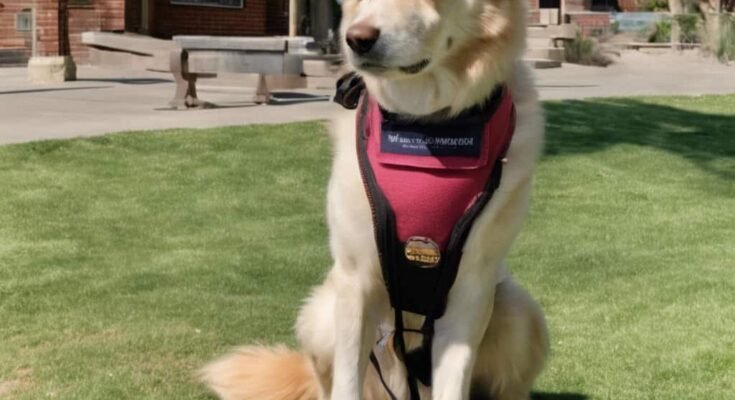Dogs have a unique way of communicating that extends far beyond barks and growls. One of their most distinctive forms of non-verbal communication is through tail wagging. For dog owners and enthusiasts alike, deciphering the nuances of tail wagging can provide valuable insights into a dog’s emotional state and intentions.
Body Language: Decoding the Wag
Not all tail wags are created equal. Each wag carries its meaning, conveying different emotions and signals:
- Broad, Loose Wag: A dog with a broad, loose wag often indicates happiness and a friendly disposition. This wag is typically accompanied by a relaxed body posture and may signal a desire for interaction or play.
- Stiff Wag: When a dog wags its tail stiffly, almost like a flagpole, it can signify alertness or tension. This type of wag might indicate that the dog is unsure or assessing its surroundings cautiously.
- Low Wag: A tail wagging low to the ground, sometimes with short movements, can indicate submission or uncertainty. Dogs may display this when they encounter unfamiliar situations or individuals.
- Fast Wag: Rapid wagging, especially with the whole rear end joining in, often indicates excitement. This can occur when greeting loved ones, anticipating a favorite activity, or encountering something stimulating.
- Tail Tucked Wag: When a dog tucks its tail between its legs but still wags slightly, it usually signals fear, anxiety, or submission. This posture suggests a need for reassurance or a desire to avoid conflict.
Lessons for Humans: Insights into Non-Verbal Communication
Studying canine communication provides humans with valuable lessons in interpreting non-verbal cues:
- Context Matters: Just as with dogs, understanding context is crucial in human interactions. A smile may mean joy or politeness depending on the situation, much like a tail wag can vary in meaning based on the dog’s environment.
- Body Language: Dogs rely heavily on body language, including tail wagging, to express themselves. Similarly, humans convey a wealth of information through gestures, facial expressions, and posture.
- Emotional Awareness: Observing dogs helps humans tune into emotions that may not be explicitly verbalized. This heightened awareness can enhance empathy and improve communication skills in various contexts.

Examples: Tales of Tail Wags
Consider the following anecdotes where dogs’ tail wagging conveyed crucial messages:
- Reunion Joy: A family returns home after a long absence to find their dog’s tail wagging furiously, signaling overwhelming joy and relief at their return.
- Stranger Danger: During a walk, a dog encounters a stranger whose stiff posture and hesitant tail wag prompt the owner to recognize the dog’s discomfort and swiftly redirect the situation.
- Training Success: A trainer observes a rescue dog’s tail gradually transforming from a tucked position to tentative wags as it learns to trust humans again, illustrating progress in its emotional rehabilitation.
Life Lessons from Dogs
Dogs have a lot to teach us about life through their simple yet profound ways of being. From loyalty to resilience, their actions and attitudes can inspire and enlighten us.
Loyalty and Trust
One of the most admirable traits in dogs is their unwavering loyalty. They stick by our side through thick and thin, showing us what true loyalty looks like. Whether it’s waiting eagerly by the door for our return or offering comfort during difficult times, dogs demonstrate the power of trust and companionship.

Unconditional Love
Dogs are masters of unconditional love. They don’t judge us based on our successes or failures; they simply love us for who we are. Their affection is constant and unwavering, teaching us the beauty of loving without conditions or expectations.
Living in the Moment
Have you ever noticed how dogs live in the present moment? They don’t dwell on the past or worry about the future; they fully embrace the here and now. Whether it’s chasing a ball with unbridled joy or basking in the warmth of the sun, dogs remind us to savor each moment and find happiness in the simplest of pleasures.
Overcoming Adversity
Dogs are resilient creatures. Many have faced hardships such as abuse, neglect, or physical challenges, yet they bounce back with incredible strength and perseverance. Their ability to adapt, heal, and trust again is a powerful testament to resilience and the human spirit.
Stories of Inspiration
- Loyalty in Action: A dog stays by its owner’s side during a long illness, offering comfort and companionship until the very end.
- Unconditional Love: A rescue dog, previously mistreated, learns to trust again and forms a deep bond with its new family, showering them with affection despite its troubled past.
- Living Fully: A playful dog reminds its owner to take breaks and enjoy life’s small pleasures, like a walk in the park or a game of fetch.
- Resilience Personified: A dog rescued from a natural disaster rebuilds its life alongside its rescuer, embodying strength and hope amid adversity.
Wisdom in Training Dogs
Training dogs isn’t just about teaching them tricks; it’s about building a strong relationship based on trust and understanding. Here’s how you can train your dog effectively while gaining valuable life skills yourself.
Training Techniques: Positive Reinforcement
One of the best ways to train dogs is through positive reinforcement. This means rewarding them for good behavior with treats, praise, or playtime. When dogs associate good behavior with positive outcomes, they’re more likely to repeat it. This method is gentle and encourages dogs to learn happily without fear or punishment.

Patience and Consistency
Patience and consistency are key in dog training. Dogs learn at their own pace, so it’s important to be patient when teaching them new commands or behaviors. Consistency means using the same cues and rewards every time, which helps dogs understand what’s expected of them. By staying calm and consistent, you can help your dog learn effectively and build their confidence.
Bonding and Communication
Training sessions are not just about teaching commands; they’re also opportunities to strengthen the bond between you and your dog. Through training, you learn to communicate better with your dog, understanding their body language and preferences. This mutual understanding fosters trust and deepens your relationship, making everyday interactions more enjoyable.
Transferable Skills
The skills you learn in training dogs can apply to many aspects of life. For instance, patience and consistency are valuable traits in relationships and work settings. Communicating effectively with your dog can improve your communication skills with people too. Moreover, the responsibility of caring for a dog teaches time management and empathy, enhancing your overall well-being.

Practical Examples
- Positive Reinforcement: Teaching a dog to sit by rewarding them with a treat when they do it right. This method encourages learning through positive experiences.
- Patience and Consistency: Practicing the same command daily until your dog understands it shows them what you want consistently. This helps them learn faster.
- Bonding Through Training: Spending time together in training sessions strengthens your bond, creating a deeper connection beyond just teaching commands.
- Applying Skills: Using patience from dog training to stay calm in stressful situations at work or at home helps you handle challenges better.
FAQs
- What is the best way to train my dog?
The best way to train your dog is through positive reinforcement. This involves rewarding your dog with treats, praise, or playtime when they exhibit desired behaviors.
- How important is consistency in dog training?
Consistency is crucial in dog training because it helps your dog understand what is expected of them. Use the same commands and rewards consistently so that your dog learns to associate specific actions with specific outcomes.
Conclusion
Training dogs isn’t just about obedience; it’s about building a relationship based on trust, patience, and clear communication. By using positive reinforcement and being consistent, you can teach your dog effectively while gaining skills that apply to everyday life. The bond you create through training is priceless, enhancing both your dog’s happiness and your well-being. Remember, training is a journey that strengthens your connection and enriches your life together.



